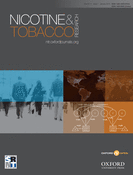-
Views
-
Cite
Cite
Florian Fischer, Martina Minnwegen, Ulrike Kaneider, Alexander Kraemer, Md. Mobarak Hossain Khan, Prevalence and Determinants of Secondhand Smoke Exposure Among Women in Bangladesh, 2011, Nicotine & Tobacco Research, Volume 17, Issue 1, January 2015, Pages 58–65, https://doi.org/10.1093/ntr/ntu129
Close - Share Icon Share
Abstract
The population of Bangladesh is highly susceptible to secondhand smoke (SHS) exposure due to high smoking rates and low awareness about the harmful effects of SHS. This study aims to determine the prevalence of SHS exposure and highlight the essential determinants in developing successful strategies to prevent adverse health effects in Bangladesh.
The analysis is based on the Bangladesh Demographic Health Survey 2011, in which 17,749 women in the reproductive age group (12–49 years) were included. The information regarding SHS exposure at home was derived from the question: “How often does anyone smoke inside your house?” The variable was recoded into 3 groups: daily exposure, low exposure (exposed weekly, monthly, or less than monthly), and no SHS exposure. We performed descriptive and bivariable analyses and multinomial logistic regression.
A total of 46.7% of the women reported high exposure to SHS at home. According to the multinomial logistic regression model, relatively lower education and lower wealth index were significantly associated with daily SHS exposure at home. The exposure differed significantly between the divisions of Bangladesh. Having children at home (vs. not) and being Islamic (compared to other religious affiliations) were protective factors.
The study indicates that women from socioeconomically disadvantaged households are more likely to experience daily exposure to SHS at home. Therefore, especially these groups have to be targeted to reduce tobacco consumption. In addition to aspects of legislation, future strategies need to focus educational aspects to improve the population’s health status in Bangladesh.






Comments